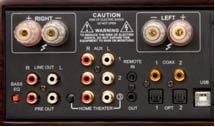|
This review page is supported in part by the sponsors whose ad banners are displayed below
|
|||||||||||||||
 |
|||||||||||||||
| Enter the Nova. The big thing here isn't the three extra buttons on the front panel to otherwise look like the Decco. Or the extra 30 watts per side. Or the extra connectivity (five digital, 3 analog inputs and 2 analog outputs). It's the ESS 9006 Sabre DAC, a 24/192 upsampling D/A converter with patented jitter reduction circuit, a 122dB S/N ratio and, in the Nova, 11 regulated power supplies. Each digital input on the Nova is transformer-coupled to avoid ground and SMPS noise, with the USB connection galvanically isolated from the computer to interrupt transmission of | |||||||||||||||
 |
|||||||||||||||
| a PC's switching power noise which otherwise "manifests itself as a major source of jitter. We eliminate it before the DAC sees it." Like the Decco, the ovoid Nova chassis can be had in Black Gloss Lacquer, Rosewood or Cherry. The sticker increase over the Decco is $400. |
|||||||||||||||
|
| |||||||||||||||
 |
|||||||||||||||
| What's so snazzy about the Sabre DAC? Stereophile's blog has the short answer. It's the "Hyperstream Modulator, which noise shapes and cascades independently stabilized lower-order modulators to achieve a nominal 90% modulation depth. It also employs a time domain interpolation algorithm to render the data into a higher clock domain without polyphase filters." | |||||||||||||||
|
|||||||||||||||
| To us civilians, that's chewy gooblygook for high-level math on what's "not a Delta Sigma converter" as engineer Martin Mallinson, formerly with Analog Devices, explained to Stereophile's Wes Phillips. It's farsighted and enterprising of the Signal Path men to license ESS Tech's IC for use in their affordable Nova D/A converter. Which is also a class A valve preamp, a headphone amplifier and a speaker amp (and perhaps in that sequence of importance or performance hierarchy but only listening could determine that). But if Jim's and David's Nova enthusiasm goes beyond proud papa-hood*, it's exactly the D/A conversion performance of the Nova which sets it apart and, as a converter alone, makes it competitive well above $1,200. Part of the Sabre tech seems to be its 8-channel | |||||||||||||||
 |
|||||||||||||||
| nature. Scaled down to stereo, it means paralleled DACs per channel for a 6dB drop in noise floor to "give us a measured 134dB dynamic range, -118dB THD from 44.1kHz to 192kHz sample rates" as Wes Phillips reported. Integral parallel processing then, with a patented modulator and a patent-pending time-domain jitter corrector. Those are the weapons the Nova packs to fight the digital demons. With USB. Considering the relative scarcity still of top-notch audiophile USB DACs for uncompromised computer audio, the Nova seems set to fill a real rather than imaginary demand. *_________________ On proud papas, the Signalpath men were going to Las Vegas with the Nova "pushing a pair of 300wpc Boulder monos into Aerial 20T speaker. The Source will be an Apple TV and PC. This will be close to a $70,000 system where old school meets new." One certainly couldn't accuse these two gents of not putting their money on their convictions. |
|||||||||||||||
 |
|||||||||||||||
Deliverance or empty promise? Before deliverance would have to be delivery. Jim Spainhour's e-mail from Shenzhen forewarned of delays. "With the present economic crunch, things have been a mess over here. We've lost multiple local suppliers in short order who went out of business. If this continues, we'll have to source parts from the US again." Manufacturing in China to gratify consumers who've become too cheap to pay for honest Euro or US labor is no longer quite the magic bullet it might have been. Besides the always acknowledged cultural and infrastructure challenges, new ones have arisen. Those won't be apparent to the consumer but are liable to raise blood pressures with designed-here/made-there outfitters... |
|||||||||||||||
|
| |||||||||||||||
 |
|||||||||||||||
|
Peachtree Audio website
|
|||||||||||||||
 |
|||||||||||||||